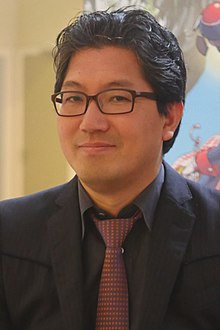Portal:Video games
The Video Games Portal

A video game, also known as a computer game or just a game, is an electronic game that involves interaction with a user interface or input device (such as a joystick, controller, keyboard, or motion sensing device) to generate visual feedback from a display device, most commonly shown in a video format on a television set, computer monitor, flat-panel display or touchscreen on handheld devices, or a virtual reality headset. Most modern video games are audiovisual, with audio complement delivered through speakers or headphones, and sometimes also with other types of sensory feedback (e.g., haptic technology that provides tactile sensations). Some video games also allow microphone and webcam inputs for in-game chatting and livestreaming.
Video games are typically categorized according to their hardware platform, which traditionally includes arcade video games, console games, and computer (PC) games; the latter also encompasses LAN games, online games, and browser games. More recently, the video game industry has expanded onto mobile gaming through mobile devices (such as smartphones and tablet computers), virtual and augmented reality systems, and remote cloud gaming. Video games are also classified into a wide range of genres based on their style of gameplay and target audience. (Full article...)
Featured articles –
The Flood's design and fiction were led by Bungie artist Robert McLees, who used unused concepts from the earlier Bungie game Marathon 2. The setting of the first game, the ringworld Halo, was stripped of many of its large creatures in order to make the Flood's surprise appearance more startling. Bungie environment artist Vic DeLeon spent six months of pre-production time refining the Flood's fleshy aesthetic and designing the organic interiors of Flood-infested spaceships for Halo 3.
The player's discovery of the Flood in Halo: Combat Evolved is a major plot twist, and was one of the surprises reviewers noted positively. The Flood's return in Halo 2 and Halo 3 was less enthusiastically praised. Reaction to the Flood has varied. While some critics have described the Flood as derivative or clichéd, others have ranked it among the greatest video game villains. (Full article...)
Set in a fictional version of classical Japan, Ōkami combines Japanese mythology and folklore to tell the story of how the land was saved from darkness by the Shinto sun goddess Amaterasu, who took the form of a white wolf. It features a sumi-e-inspired cel-shaded visual style and the Celestial Brush, a gesture-system to perform miracles. The game was planned to use more traditional realistic rendering, but this had put a strain on the graphics processing of the PlayStation 2. Clover Studio switched to a cel-shaded style to reduce the processing, which led to the Celestial Brush concept. The gameplay is modeled on The Legend of Zelda, one of director Hideki Kamiya's favorite series. The game's name is a pun, as "ōkami" can mean either "great god" (大神) or "wolf" (狼) in Japanese.
Ōkami was one of the last PlayStation 2 games released prior to the release of the PlayStation 3. Although it suffered from poor sales, the game received critical acclaim, earning IGN's 2006 Game of the Year. The Wii version earned similar praise, though the motion control scheme received mixed reviews. A high-definition port, remastered by Capcom and HexaDrive, was released on the PlayStation 3 via the PlayStation Network in October 2012 and for retail in Japan in November, supporting the use of the PlayStation Move motion controller. The port was released for PlayStation 4, Windows, and Xbox One in December 2017 worldwide, for the Nintendo Switch in August 2018, and for Amazon Luna in April 2022. Mainstream adoption of the game has improved with the release of these remasters, and Ōkami is considered to be one of the best video games ever made, as well as an example of video games as an art form, aided by the improved art details and graphics resolutions. (Full article...)
Minerva's Den was created by a small team within 2K Marin led by Steve Gaynor, who partly based the setting on ideas he discussed in his hiring interview. The team decided upon a small, personal story about identity and free will, which explores an unseen part of the underwater city of Rapture. Minerva's Den was initially released for PlayStation 3 and Xbox 360 consoles in August 2010, and was later released and reissued on other platforms. It was well received by critics, who praised its story, characters, and gameplay; reviewers, including those writing for Kotaku and Paste, considered it one of the best video game expansions of all time. The experience of creating a small, story-focused project inspired Gaynor and other 2K employees to form The Fullbright Company and create Gone Home (2013). (Full article...)
Halo Wars was unveiled at the X06 Xbox show in 2006. Ensemble designed the game specifically for the Xbox 360 controller, in an attempt to circumvent issues present in previous console RTS titles. Ensemble was closed by Microsoft before the game's release, but soon after Robot Entertainment was founded by many of Ensemble's former employees; this new company continued to support Halo Wars with updates and downloadable content.
Halo Wars received generally positive reviews. Reviewers lauded the game's pre-rendered cinematics, attention to detail in replicating the Halo universe, and intuitive control scheme. Complaints against the game included the lack of an option to play as the Covenant faction in campaign mode as well as the lack of strategic options during play. Critics from GameSpot and USA Today wrote that experienced RTS players would find the strategic elements of the title shallow. The game sold one million units worldwide through March 2009, making it the best-selling console real-time strategy game to date. An enhanced version of the game—Halo Wars: Definitive Edition—was released for Windows and Xbox One in December 2016. Halo Wars 2, a sequel developed by 343 Industries and Creative Assembly was released in February 2017. (Full article...)
The name Alleyway references the in-game gateway that the player's spaceship (represented as a paddle) must pass through. While Alleyway is a portable clone of Breakout, it adds several features, including alternating stages, bonus rounds, and hazards for the player at later levels. While the game's original box art featured an unidentifiable protagonist, later international releases of the game replaced the character with Mario. Alleyway was released with limited advertising, receiving moderate to low scores from reviewers who compared it to games like Arkanoid. (Full article...)
Portal consists primarily of a series of puzzles that must be solved by teleporting the player's character and simple objects using "the Aperture Science Handheld Portal Device", also referred to as the "portal gun", a device that can create intra-spatial portals between two flat planes. The player-character, Chell, is challenged and taunted by an artificial intelligence named GLaDOS (Genetic Lifeform and Disk Operating System) to complete each puzzle in the Aperture Science Enrichment Center using the portal gun with the promise of receiving cake when all the puzzles are completed. The Source Engine's physics system allows kinetic energy to be retained through portals, requiring creative use of portals to maneuver through the test chambers. This gameplay element is based on a similar concept from the game Narbacular Drop; many of the team members from the DigiPen Institute of Technology who worked on Narbacular Drop were hired by Valve for the creation of Portal, making it a spiritual successor to the game.
Portal was acclaimed as one of the most original games of 2007, despite some criticism for its short duration. It received praise for its originality, unique gameplay and a dark story and sense of comedy. GLaDOS, voiced by Ellen McLain in the English-language version, received acclaim for her unique characterization, and the end credits song "Still Alive", written by Jonathan Coulton for the game, was praised for its original composition and humor. Portal is often cited as one of the greatest video games ever made. Excluding Steam download sales, over four million copies of the game have been sold since its release, spawning official merchandise from Valve including a model portal gun and plush Companion Cubes, as well as fan recreations of the cake. (Full article...)
Kingdom Hearts is a crossover of various Disney properties based in an original fictional universe. The series centers on the main character, Sora, and his journey and experiences with various Disney characters, as well as some from Square Enix properties, such as Final Fantasy, The World Ends with You, and Einhänder, in addition to original characters and locations created specifically for the series.
The series consists of thirteen games available for multiple platforms, and future games are planned. Most of the games in the series have been positively received and commercially successful. As of March 2022, the Kingdom Hearts series has shipped more than 36 million copies worldwide. A wide variety of related merchandise has been released along with the games, including soundtracks, action figures, companion books, light novels, a collectible card game, and a manga series. (Full article...)
Resident Evil: Apocalypse is set directly after the events of the first film, where Alice escaped from an underground facility overrun by zombies. She now bands together with other survivors to escape the zombie outbreak which has spread to the nearby Raccoon City. The film borrows elements from several games in the Resident Evil series, such as the characters Valentine and Olivera and the villain Nemesis. Filming took place in Toronto at locations including Toronto City Hall and Prince Edward Viaduct.
Resident Evil: Apocalypse received "generally unfavorable reviews" on Metacritic, and became the lowest-rated film in the Resident Evil series on Rotten Tomatoes, with a rating of 19%. Despite this, it earned $129.3 million worldwide on a $45 million budget, surpassing the box office gross of the original film. It was followed by Resident Evil: Extinction in 2007. (Full article...)
Although the game's development appeared to be proceeding towards completion without difficulty, LucasArts abruptly canceled production of Freelance Police in March 2004, citing economic and market conditions. The game's cancellation was received poorly by fans of the series, Steve Purcell, and the video game industry media. Many journalists viewed this move as a culmination in the decline of the adventure game genre. LucasArts later terminated its adventure game development, and many of the Freelance Police design team left to create Telltale Games and continue development of such adventure games. Steve Purcell moved the Sam & Max franchise to Telltale Games in 2005, prompting a revival of Sam & Max video games. (Full article...)
Did you know... -
- ... that the web-based video game Moderator Mayhem was based on a card game meant to demonstrate the difficulties of content moderation?
- ... that MicroProse was formed to publish Hellcat Ace after Sid Meier boasted that he could design a better video game than Red Baron in a week?
- ... that a video game consisting solely of a clickable image of a banana was briefly the second-most played game on Steam?
- ... that the success of Kingdom Rush prompted plans to grow the video game industry of Uruguay?
- ... that the team developing the action video game Knights Contract researched European folklore on witches and witch hunts?
- ... that the 1979 video game Superman was one of the first console games with a pause feature?
- ... that fighting video game Panza Kick Boxing was endorsed by a French kickboxing champion who also supplied technical advice?
- ... that Rockstar Vienna was the largest video game developer in Austria when it closed in 2006?
- ... that the case Lewis Galoob Toys, Inc. v. Nintendo of America, Inc. was considered essential to the future of video game modding in the United States in 1992?
- ... that the urban legend Herobrine was ranked on a Guinness World Records poll of the best video game villains, despite never existing?
- ... that a reviewer thought that the video game Robbery Bob contained cringeworthy dialogue?
- ... that the Chicago Sun-Times credits JumpStart Toddlers as the first video game targeted towards babies?
Selected biography –
Selected image -

Recent video game-related events
- September 12, 2024 – 2023–2024 video game industry layoffs
- Microsoft announces that it will lay off 650 Microsoft Gaming employees as part of cuts to its workforce. (Variety)
- August 15, 2024 –
- American video game magazine Game Informer discontinues publication after 33 years. The magazine's website is also shut down. (BBC News)
- May 24, 2024 – Uvalde school shooting
- Families in Uvalde, Texas, U.S., file a lawsuit against Daniel Defense and Activision Blizzard for creating the DDM4 V7 gun and promoting the weapon through the game Call of Duty, respectively. They also sue Meta Platforms for owning Instagram, which was used by the gunman. (AP)
Topics
Categories
Things you can do
In other Wikimedia projects
The following Wikimedia Foundation sister projects provide more on this subject:
-
Commons
Free media repository -
Wikibooks
Free textbooks and manuals -
Wikidata
Free knowledge base -
Wikinews
Free-content news -
Wikiquote
Collection of quotations -
Wikisource
Free-content library -
Wikiversity
Free learning tools -
Wiktionary
Dictionary and thesaurus













































